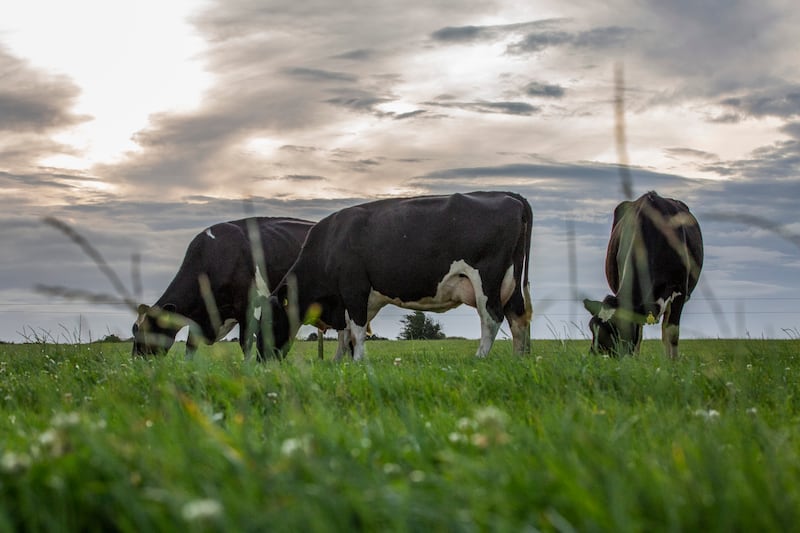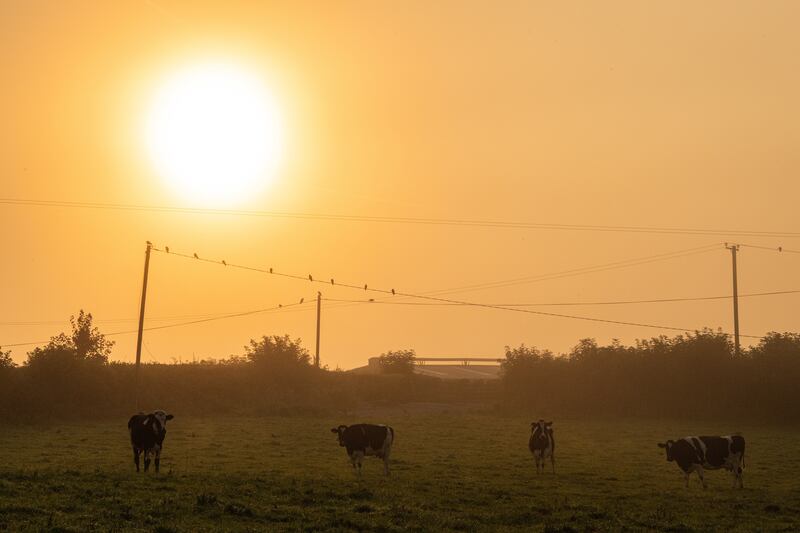In advance of the 2023 climate action plan setting legal limits on emissions from agriculture, Ireland’s leading dairy farmers are seeking ways to become more sustainable.
A visible improvement in biodiversity is one of the things that animates Eamon Sheehan of Cuffesgrange, Co Killkenny. Since he adopted a new veterinary plan of only-when-needed treatments, he has seen big changes. “It had a huge knock-on effect,” said Eamon.
The reduced use of medicines has led to an increase in the beetles that feed on the dung that cattle leave behind in the pasture. “They’re breaking down the dung and burrowing into the soil,” explained Eamon, who believes that the resulting increase in insect life on the farm has increased the activity of bats.
There are also birds such as kestrels and sparrowhawks, and there are even otters on the farm. It’s just one of a host of initiatives over many years by Eamon, and by his father previously, that have improved the sustainability of the 250 acres where he produces milk from 200 cows.
READ MORE
Their land is one-fifth space for nature, an important concept in the new Common Agricultural Policy from January. As one of the National Dairy Council Ambassadors, advocates for Ireland’s grass-fed dairy production system, he champions initiatives to make Irish dairy ever more environmentally-friendly.

Multispecies pasture
In Co Waterford it’s the chicory that impresses Shane Fitzgerald at Portlaw, where milk is produced from 210 dairy cows.
Shane is an early adopter of multispecies pasture with plantain, chicory, clover and other grasses and herbs, which are recommended in addition to the perennial ryegrass on which farmers have depended for decades.
Multispecies pasture makes up 10 per cent of Shane’s farm. It reduces the need for chemical nitrogen fertiliser (which causes emissions) and pesticides and improves soil health.
“We have been focusing too much on above the ground, we have to try to improve soil health”
Shane has been digging up pastures and marvelling at the long roots of the chicory, which he says are really beneficial for the soil and for soil life, including earthworms. “I could see the soil structure has improved, even though we only started sowing it [multispecies] last autumn.”
“It’s a big thing going forward, we have been focusing too much on above the ground, we have to try to improve soil health.”
Climate strategy
Shane and Eamon are leading with measures for reducing greenhouse gas emissions, increasing carbon sequestration and improving sustainability. They are needed because, as Agriculture Minister Charlie McConalogue TD has said, the 2023 climate plan budgets “will challenge the sector like never before”.
At the recent launch of the Climate Action Strategy 2022-2030 by Teagasc, Ireland’s agriculture and food development authority, he said: “Farm families have been on a journey towards lower-carbon systems for some time. We are now stepping forward those ambitions and we stand full square behind them on this future journey.”
At the same launch Teagasc director Professor Frank O’Mara noted: “We should take encouragement from the rates of adoption of low-emissions technologies by farmers so far,” which was due to acknowledgment of the years of efforts on the Sheehan and Fitzgerald farms, and many more like them.
Legacy for the next generation
Farmers aren’t waiting. Shane Fitzgerald said, “The way I look at it, this is our part of the world here, we have to look after the environment and reduce emissions, and leave the land in better shape for the next generation – any farmer will tell you they always want to leave the land better for the next generation”.
“It doesn’t make sense for us to harm the environment, to run down the soil, to damage the land we work on, we rely on it for our livelihood,” he says.
“That’s why we want to reduce emissions, to leave a legacy that we did the right thing.” Eamon Sheehan said, on behalf of his family.
“It doesn’t make sense for us to harm the environment, to run down the soil, to damage the land we work on, we rely on it for our livelihood”
“It has always been of interest to us, trying to farm sustainably. We’ve been doing this since before it became fashionable.”
Sheehan and Fitzgerald have both embarked on two years of studying for a diploma in environment, sustainability and climate, through University College Cork and Tirlán (formerly Glanbia), the dairy company they supply with milk. Tirlán fully funds 20 diploma students each year, to “support milk suppliers” in their on-farm sustainability journey.
“We’re trying to upskill and learn as we go,” said Sheehan. “You have to do something and try to be proactive.”

Early adopters
Both are aware that farm efficiency and herd health are economically better for the farm, while reducing the carbon hoofprint of a litre of milk.
Both farmers started early with environmental improvements, by adopting low-emission slurry spreading and protected urea fertiliser. Now nearly 90 per cent of dairy farms have adopted the former, and more than 30 per cent use the latter, according to the Teagasc National Farm Survey Sustainability Report.
Both have incorporated clover in pasture, to reduce reliance on chemical nitrogen, as clover adds nitrogen from the air to the soil.
They also reduce emissions with up-to-date cow breeding strategies. Eamon said the cows have collars that send a signal when they are ready for breeding. This has allowed the farm to rely 100 per cent on artificial insemination, selecting specific traits (including low emissions) for their cows.
Shane uses similar breeding strategies. He said the biggest scope now is to speed up breeding of more efficient cows with high feed conversion, smaller animals with a lower carbon hoofprint per litre of milk.
Sheehan has also had very good results from feeding probiotics to calves, for the first 20 days, thus preventing a lot of health issues in the calf and in the cow later in life. Researchers in New Zealand say probiotics may yet be one of the answers for lowering livestock methane emissions.
Signposting the way forward
Teagasc has been informing the dairy sector on new farming methods that will be more sustainable. Its Signpost programme is a whole-of-industry partnership, led by Teagasc and involving over 60 agri-food organisations, set up to support and enable farmers to take climate action.
Dr Tom O’Dwyer, head of the Signpost programme says: “There are three parts to the programme including a network of demonstration farmers – the Signpost farmers – and a research experiment to measure the rates of carbon sequestration (the process of locking carbon dioxide from the atmosphere into the soil and keeping it there) on different soil types and under different management regimes. The aim is to establish an accurate baseline for current carbon absorption rates in Ireland across the different soil types and land usages.
“The third part – the Signpost advisory programme – has been launched recently and will support dairy farmers to make the changes already taken by our Signpost dairy demonstration farmers, and farmers like Eamon and Shane. The objective of the overall programme is to bring science to practice, and we believe that we can do this over the coming years.”
Reducing emissions by 25 per cent before the end of the decade is a target that will test farmers. But the future of Ireland’s dairy system, together with the agri-food sector as a whole, which is one of the country’s largest and most important indigenous business sectors, is in good hands with farmers like the Fitzgeralds and the Sheehans leading the way.













